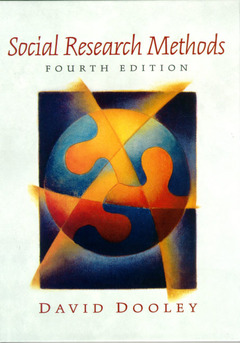Description
Social research methods, 4th ed 2000
Author: DOOLEY
Language: English
Approximative price 66.19 €
Subject to availability at the publisher.
Add to cart400 p. · Paperback
Description
/li>Contents
/li>Comment
/li>
I. INTRODUCTION TO SOCIAL RESEARCH.
1. The Logic of Social Research: Ruling Out Rival Hypotheses.
2. Ethics: Protecting Human Subjects and Research Integrity.
3. Finding, Using, and Writing Research Reports: Library Usage and Report Style.
II. THEORY AND MEASUREMENT (CONSTRUCT VALIDITY).
4. Theory: Tentative Explanations.
5. Measurement Theory: Toward Validity and Reliability.
6. Types of Measures: Finding and Using Them.
III. SAMPLING: SURVEYS AND INFERENCE (STATISTICAL INFERENCE VALIDITY).
7. Survey Data Collection: Issues and Methods in Sample Surveys.
8. Inferential Statistics: Drawing Valid Conclusions from Samples.
IV. EXPERIMENTAL AND NONEXPERIMENTAL DESIGNS (INTERNAL AND EXTERNAL VALIDITY).
9. Designing Research for Internal Validity.
10. True Experimentation: External Validity and Experimental Construct Validity.
11. Quasi-Experimentation: When Multiple Groups and Random Assignment Are Not Possible.
12. Correlational Methods: Controlling Rival Explanations Statistically.
13. Qualitative Research: Participant Observation.
V. DRAWING CONCLUSIONS.
14. Interpreting Research: Overview of Research Design and Review Methods.
15. Applied Social Research.
Appendix A: Social Research and the Internet.
Appendix B: Statistics Review.
Glossary.
References.
Name Index.
Subject Index.
- New - Chapter-length appendix - Covers the World Wide Web as a digital library and as a virtual laboratory with electronic access to grant resources, human subject forms, measurement tools, and data, and as an electronic publication outlet with discussion of Web page authoring and copyright issues.- Provides students with access to article abstracts and text journals.
- New - Web Sites section in each chapter - Suggests interesting sites related to the content of each chapter. - Updates instructors with new ways the Internet can be used in research. Provides students with a host of Web site addresses or URLs that can be explored as a supplement to the text.
- New - 100 new references - Fine tunes and updates the text with new material yet retains the length o




